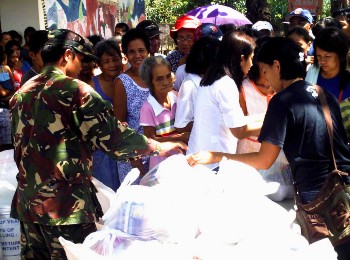About 1 result/s
-
Volume 5, Issue 2, September 2023
How can local governments build the resilience of disaster-affected households? This is an important concern since climate change is expected to worsen climate-related disasters especially among vulnerable sectors such as the urban poor in developing countries. For the Philippines, the most at-risk country in the World Risk Index 2022, it is important to address the vulnerability of the urban poor living in danger zones.

-
Volume 5, Issue 1, March 2022
Bringing aid to disaster-stricken communities is complex, especially in the Philippines where destructive typhoons are intensifying due to climate change. This paper illustrates the coordination for humanitarian aid from Philippine government instrumentalities, the military, uniformed personnel, and civilian sectors as well as from, multilateral organizations and non-government organizations, both local and international during state of national calamities like Typhoon Haiyan. Disaster response increases in complexity in conflict zones such as Bangsamoro Autonomous Region of Muslim Mindanao (BARMM), where armed non-state actors have been active for many years. Encapsulated are the perceptions of 30 respondents coming from government agencies involved in disaster risk reduction and management, including the military and uniformed personnel including humanitarian and relief agencies, during both peacetime and conflict. This embodies challenges in civil-military engagement in balancing mandated tasks such as security, maintaining peace and order, preserving sovereignty, and preventing terrorism with adherence to humanitarian principles and frameworks even while striving to deliver basic humanitarian services in the nexus of climate change and conflict.

-
Volume 4, Issue 1, January 2020
This paper connects climate change and hydrometeorological
calamities based on econometric evidence that links atmospheric CO2
accumulations to floods and storms. The study uses climate data from 155
countries, with a period spanning 46 years (1970–2016) and adopted a
statistical and econometric approach to assess the factors that have
contributed to the increase in the frequency of intense flood and storm events.
Findings showed that the number of climate disasters could double in less than 21
years, and thus severely damage the environment, socioeconomic progress, and
welfare of millions of people worldwide.

-
Volume 3, Issue 1, December 2018
Only few studies investigated the adaptive capacity or
adaptation practices of indigenous peoples (IPs) in the Philippines and none so
far in the Compostela Valley. Since the landslide and flash flood events in
2012 brought by Typhoon Bopha, no systematic study has been conducted to
compare the adaptive capacity of IPs and non-IPs in New Bataan’s most affected
communities. This paper contributes to the assessments of adaptive behavior
with the ultimate goal of stimulating adaptation support to the most vulnerable
people.

-
Volume 3, Issue 1, August 2018
In 2013, Super Typhoon Haiyan, one of the strongest tropical
cyclones to impact the Philippines, made landfall in Tacloban City. The typhoon
incapacitated the city, breaking down its main lifeline, the transport system.
This article analyzes how a weakened transport system exacerbates disaster
vulnerability, specifically manifested in the restricted mobility and access of
people and communities immediately after an extreme event.
-
Volume 2, Issue 2, July 2017
The very real threat of climate change requires effective disaster risk management (DRM), especially in highly vulnerable ecosystems such as island communities. Past disaster experiences in different parts of the world have revealed the importance of integrating traditional ecological knowledge (TEK) with scientific fndings in managing disaster risk.
-
Volume 1, Issue 1, January 2016
Climate-related hazards can lead to disasters in communities with lower socioeconomic conditions, inadequate access to basic social and infrastructure services, and poor institutions. The impacts of Typhoon Haiyan that struck the Philippines in 2013 not only highlighted the exposure of several cities but also indicated the underlying causes of their social vulnerability to climate-related hazards.
-
Volume 1, Issue 1, January 2016
Recent extreme weather events have brought devastating impacts on people’s lives and infrastructure in many parts of the world. The scale of the impact of Typhoon Haiyan in the Philippines revealed a high degree of vulnerability and exposure of coastal communities to extreme events in a region that is regularly hit by tropical cyclones.